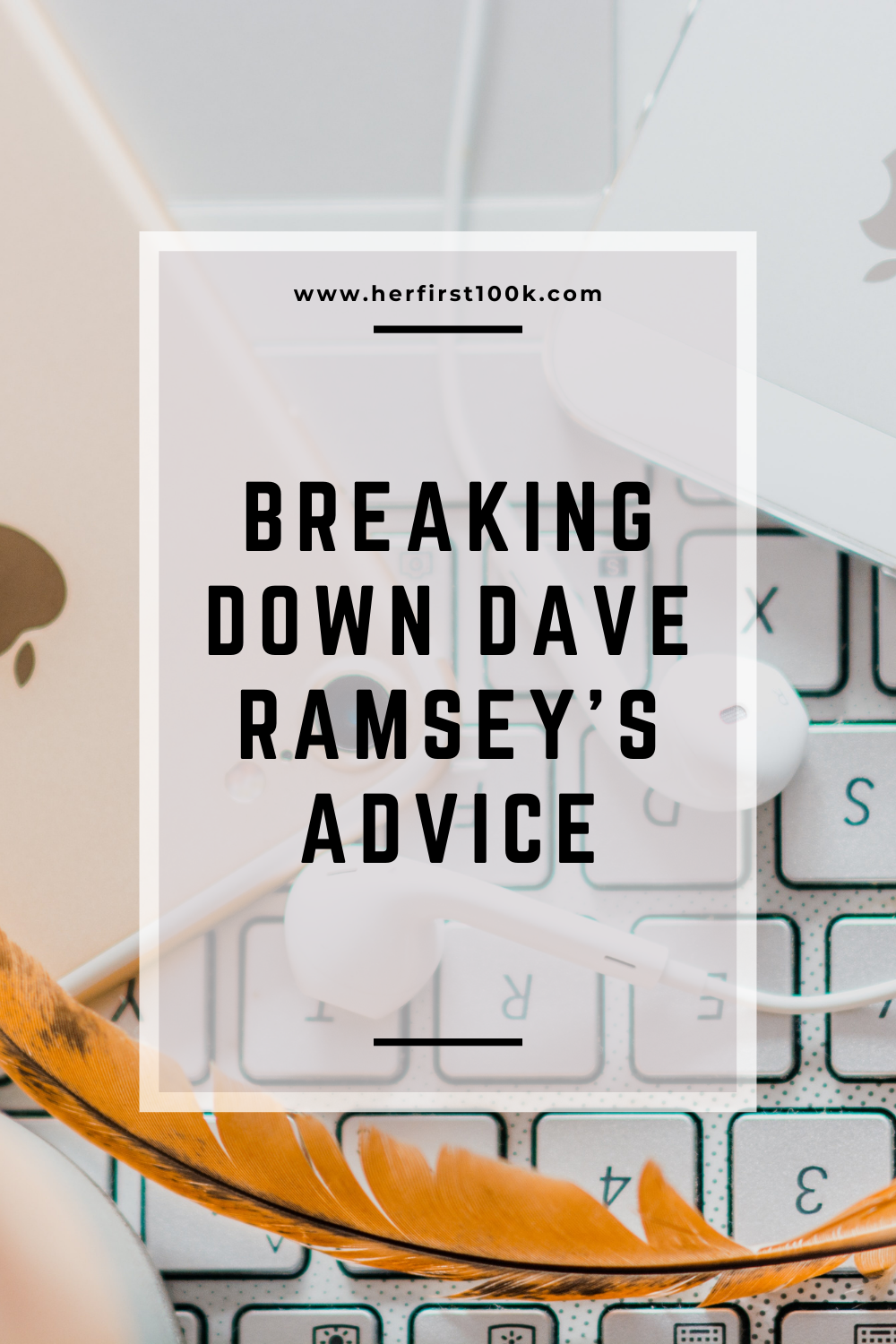The following article may contain affiliate links or sponsored content. This doesn’t cost you anything, and shopping or using our affiliate partners is a way to support our mission. I will never work with a brand or showcase a product that I don’t personally use or believe in.
Breaking Down Dave Ramsey’s Financial Advice
If you grew up on a diet of Dave Ramsey or found him at the beginning of your financial journey, you’re familiar with his seven baby steps and overall beliefs about money. It’s not exactly a secret that I’m not Dave’s biggest fan, but I recognize that so many people go through his programs or come into contact with his ideology in personal finance.
Here’s the thing— I don’t disagree with everything Dave has to say financially, and I won’t negate that he has helped people.
However, I take issue with the way he interacts with his guests, how he runs his company (allegedly firing women for getting pregnant out of wedlock while hiding the infidelity of one of his male personalities— my eyes can not roll back far enough), the way he consistently ignores systemic racism and inequality, and his overall attitude of “my way is the only way.”
Today, in an attempt to stay relatively positive, I’m going to be offering the other side of some of Dave’s popular advice. If his way works for you, that’s amazing! But you should also see the other side of the coin and understand why another way may be more beneficial for you in the long term.
$1,000 Emergency Fund → 3 Month Emergency Fund
Baby step #1 in the Dave Ramsey method is putting together a $1000 emergency fund. At the core, he’s right–– you need an emergency fund before you start paying off debt aggressively. Where I see this not working out is the $1,000 part.
I understand the idea of this is to make it more accessible and less daunting, which I applaud! Statistically, most Americans can’t afford a $600 emergency, let alone a $1,000 one. So this number is already likely to feel high if you’ve never built a rainy day fund before.
However, $1000 for an emergency is very little in the grand scheme of things and in most cases, will barely cover an emergency. When an emergency that costs more than $1000 comes up, you’ll be reaching for your credit cards again to cover the cost. We don’t want you going deeper into debt trying to pay for an emergency.
Instead, consider a 3-month emergency fund (aka your non-negotiable expenses) in a High Yield Savings Account as a starting place. If shit hit the fan today and you lost your job, this fund would give you three full months of living expenses.
Paying off student loans before investing → Investing while paying student loans
We get it –– Dave is the “all debt is bad debt” guy. I can’t blame him for staying on message. Unfortunately, this is an area where he’s woefully out of touch.
The cost of college has increased 144% in the last twenty years, and wages have barely moved in that time (we’ve not seen a minimum wage increase in OVER A DECADE). For many, the idea of paying cash for college is simply unrealistic. Here in Washington, even state schools cost $15,000 – $20,000 a year, and that comes before other expenses. Even if you were to work full-time and take on a full course load, it may not cover this tuition— and that’s if you have the time, transportation, and ability to take on a full-time job while in school.
Student loans have put an undue burden on graduates in the last two decades, and it’s only getting worse. You should not feel shame for taking out a student loan if you need it. The truth is, schools and financial aid departments followed a script that allowed students to enter into agreements they didn’t fully understand.
So why does Dave say you should pay it off before saving for retirement? I have absolutely no idea. Seriously, this one is the one that baffles me the most, especially when you’re seeing graduates coming out of school with six figures of debt.
A rule of thumb when you’re considering paying off your loans or saving for retirement is the 7% rule. If your student loan’s interest rate is below 7%, then you need to, at the very least, be contributing to the employer match in your 401K and contributing to an IRA. If you have extra cash after that? Sure, throw it at that student loan.
We use the 7% rule because even at the most conservative estimates, the annual rate of return of the stock market averages 7%. When you are not investing and instead, paying off lower interest debt, you’re not using your money most efficiently.
If you have private loans and are considering refinancing to lower your interest rates, check out our partner, Juno!
Buying a home on a 15-year loan → Buying a house on a 30 year and investing the difference
Like many millennials, I choose to continue renting. This is partially because I enjoy the opportunity to be a digital nomad and not be tied to one place, but also because in the city, renting is currently way more affordable than buying.
But as you get older, the allure of home buying may start to overtake your love for casual living.
One of Dave’s (and other financial advisors’) pieces of advice is to only buy a home when you can 1) put 20% down AND get a 15-year fixed-rate mortgage.
On paper, a 15-year makes “sense.” You pay more month to month, but your house is paid off in 15 years, and WOW, look how much you save in interest!!
But wait…remember that pesky 7% interest rule?
Most mortgages are well below 7% (and if you’re looking at 7% or higher mortgages, PLEASE reconsider), and instead of paying that higher monthly rate, you could take the difference and start putting it into a brokerage account and let that money grow with the help of compound interest.
Let’s illustrate. You go to purchase a $300,000 home and put 20% down with a 15-year fixed-rate mortgage at 3.5% interest.
Your monthly mortgage will be $1979, and by the time you pay off the house, you’ll have paid $68,869.68 in interest. Making your total cost for the home $368,869.
Now, let’s do the math with a 30-year fixed-rate mortgage at 3.5% with 20% down on that same home. This time though, we’re going to invest the difference over that 30 years.
Your monthly mortgage will be $1341, and by the time you pay off the house, you’ll have paid $148,169.50 in interest, making your total home cost $448,169.50.
BUT WAIT! You invested that extra $638 a month ($1979-$1341) in a brokerage account, which earned you an average of 7% return. At the end of 30 years, that brings that total to a whopping $818,924.
So yes, you pay an extra $80,000 in interest with a 30-year loan, but you walk away with $800,000 if you invest the difference.
Is that 7% rule starting to make a little more sense?
Beans and rice/never eating out → Value-based spending
Perhaps the most frustrating of Dave’s advice –– “you should not see the inside of a restaurant while paying debt unless you work there.”
Just. Ugh. No.
Listen, I am all for attacking debt like it kicked your mother, but this advice is unrealistic and borderline cruel. You can and should find some joys in your life –– and yes, you can still go on dates, go to concerts, and even take vacations while you’re paying off your debt!
Try switching from a total deprivation mindset to a value-based spending mindset. With value-based spending, you choose three categories that genuinely bring you joy and carve out a space in your budget for them. For example, I love spending money on plants, going out to eat, and traveling. So each month, a portion of my budget is dedicated to those categories.
You don’t have to spend extravagantly or without limits in these categories. A rule of thumb is that non-essential spending should be no more than 30% of your monthly budget –– so start with those parameters and go from there.
I’m going to repeat it again: you should not shame yourself into being miserable just because you have debt. You can live an enjoyable life while still getting your financial shit together. Balance is the name of the game.
Where I agree with Dave: Saving for your kid’s college → Prioritizing retirement
I thought it was only fair to share the times that I do agree with Dave (see, I can be reasonable!). When it comes to retirement vs. saving for your kid’s college or paying off your home early, your retirement needs to take priority.
You can take out a loan for students, but you cannot take out a loan for your retirement. I love the common metaphor of putting on your air mask first before helping others, and it rings especially true in this scenario. The natural inclination is to drop it all and do everything for your kids, but remember, you cannot help them if you cannot take care of your own financial needs.
Once you’ve started regularly contributing to your retirement accounts, you might consider a 529 or other college funds to start for your children. We love UNest for this, as it allows family members to contribute to the funds!
Anytime you’re working to better your financial situation, you’re giving yourself momentum –– so don’t kick yourself if some of this information is new to you or you’ve been doing it “the Dave way” for a long time. At the end of the day, personal finance is personal, and you get to decide which way works best for you and your family.
Resources:
Blog: The Best and Worst Advice for Paying Off Debt
Free Community: The $100K Club



